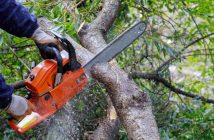(The High Desert Industrial Park, a 127,000-square-foot building park that is 50 percent leased | Courtesy of Fratzke Commercial Real Estate Advisors, Inc.)
There is a bumper sticker that can be seen around town with a map of Oregon and the words, “We’re Full” in the middle. A couple of years ago, that sticker may have brought on a chuckle. However, a little more than a year into the pandemic and in the midst of what is perhaps the hottest real estate market in history, that sentiment aptly sums up the commercial property situation in Central Oregon.
“We are getting three to five calls a week from people in California looking for commercial space. We have to tell them we just don’t have the inventory. It’s another cycle in the crazy world of real estate, and in Bend it goes up and down like a roller coaster,” says Brian Fratzke, principal broker and founder of Fratzke Commercial Real Estate Advisors, Inc. “People from other areas just don’t realize what a small town we actually are compared to L.A. or Houston. It’s crazy times. We are not paid to say no, but we have to. We are spending a lot of time with people who are new to our area, explaining to them that we are not a big town. They get kind of mad; they think we don’t want to lease to them. We do, but we just don’t have the space.”
As with their residential counterparts, realtors on the commercial side of business are also having record years. “It’s hard to imagine it has been over a year already since the pandemic hit. For certain, it has altered the ways we interact with others and essentially how we do business. That said, my business has remained strong, and I am grateful to say that I have stayed very busy helping clients with selling, leasing and acquiring commercial properties,” says Ryan Amerongen, CCIM, a broker with RE/MAX Key Properties Commercial in Bend. “It is a fast-moving market with a high demand and low inventory, so you have to help your clients really define what they are looking to do, and, importantly, be able to act immediately when the right opportunity presents itself.”
Huge Demand, Not Much Supply
Fratzke, who started as a broker in Bend in 2004 when the market was going through the roof, opened his own company in September of 2007, which he says was the worst time to open a brokerage in 75 years. “We struggled like all get out. But now, here we are again with a three-minute supply. For us as a company, we have hired three additional people in the past few months. I’m proud of us that we did this; I thought we might have to be down five people. But people really need a commercial real estate advisor and a business advisor right now, because things are expensive and it’s complicated.” Fratzke says he predicted a year ago that the real estate industry would get through the pandemic, and that he was afraid that once we got past it, there would be “more demand for real estate here than ever in the history of mankind,” he says with a laugh. “People thought I was crazy, but I was 100 percent right. The last time we had this crazy market, people were trying to come here, and it was all about family and quality of life. With COVID, people are making decisions based on this. They are leaving big cities; it’s like the Oregon Trail all over again.”
Pat Kesgard, CCIM, partner and principal broker with Compass Commercial, says that because the available inventory of all types of properties is so limited, lease rates and prices have been driven to an all-time high. “In Q2 2020, commercial real estate in Central Oregon was negatively affected due to COVID concerns. Fortunately, activity later came back very strongly in Q3 and Q4. Compass Commercial Real Estate Service’s transaction volume in 2020 was essentially equal to 2019, which was our largest year.” He adds, “So far in 2021, we are extraordinarily busy working to find properties to lease or to purchase for clients. We continue to lease office, retail and of course industrial space, and we have several restauranteurs who are looking for locations as well. Since we have virtually no speculative construction, we do not have an adequate supply of retail and office, unlike in the larger metro urban markets. In these markets, they are awash in both segments with high vacancies.”
“There are many factors currently affecting the commercial real estate industry, specifically in Central Oregon,” says Kodiak Malmstrom, principal broker/owner of Kodiak Commercial Real Estate INC. “The largest is the infusion of new residents from across the country moving to the area. This demand will continue the rebound of commerce in nearly all sectors, with the exception of largely populated-dependent businesses such as concerts, events, large box stores and large office settings.” He adds, “With vaccinations available for nearly all classes of citizens, restrictions should continue to be lifted over the next couple of years. That said, Central Oregonians are ready to get out and socialize. I am extremely optimistic for Central Oregon and the opportunities that will come with this rapid growth.”
The challenge with the influx of city dwellers moving here, Fratzke says, is that people are leaving cities without really understanding that they may not have a house to buy when they arrive, or if their boss will continue to let them work from home. “We have demand in every sector of the commercial market: buyers, investors and tenants,” he says.
Throughout the supply crunch, Realtors have had to adapt to the new ways of conducting business due to COVID. Amerongen says that not being able to interact with clients and colleagues in person has been difficult. “Like so many businesses, mine is built on relationships. Those relationships are most often built on shared interactions, getting to know one another and earning each other’s trust. Today, many meetings are digital, so I have had to adapt by finding ways to make digital interactions as personal as possible. There are more Zoom, email and phone contacts and less in-person discussions. And when we are in person, it is hard to not immediately shake hands; it is such a habit!” To help cope with the fewer face-to-face interactions, Amerongen says he focuses on listening intently to a client’s goals, defining shared expectations and responding to them quickly.
Outlying Areas Getting Bend’s Overflow
As Bend continues to bulge at the seams and commercial availability remains low, the outlying areas are receiving the overflow. “The vacancy rate for industrial is about three percent. It’s that way everywhere, even in Madras. You’d think it would be sleepy there, but it’s not,” says Bruce Barrett, a broker with Windermere Central Oregon Real Estate in Redmond. “Personally, at the end of last year, it was a record year for commercial leasing and sales. I had eight individual lots the first of last year, and now all but one are in escrow,” he says. “I have some industrial building space leases; I just listed one two weeks ago, and I’ve shown it three to four times per week and have three letters of intent on the last one I have left to lease. As soon as something comes up on the market, you’ve got a bunch of people who want it.”
In Redmond, Barrett says there are a few commercial space listings. “But if you have a specific need, probably two out of three of those spaces won’t work for you. The bottom line is that people want to come here, to move here, and have ideas about starting a business or moving a business here, but it’s tough to find a location.”
Barrett says that John Stark, senior director of Redmond Economic Development Inc. (REDI), recently reported that he completed 11 or 12 relocation and expansion projects in Redmond, which is a record. “He’s never completed that many before,” says Barrett. “Normally he averages around six.”
To help with the increased demand by businesses and the lack of land in Redmond, Barrett says Stark is working with the City of Redmond and with developers to look into solutions such as expanding lots and building small industrial facilities on them, or working on rezoning. “The big news going forward is that progress is likely to happen in La Pine or Redmond, because that’s where property is available. La Pine has a large industrial park with inexpensive water and power, which makes it attractive, but the problem is the commute. Redmond is going to be the likely place for growth in Central Oregon.”
Malmstrom adds, “The shortage of developable land in Bend has spiked the raw land costs. With the expansion of the Urban Growth Boundary, annexation and realigning of city limits, this will help offer new opportunities in the future. But surrounding communities, specifically La Pine, Redmond, Prineville and Madras, are reaping the benefits of high costs and have started seeing a spike in new development. I see the greatest development and investment opportunities in these communities for the next three to five years.”
Kesgard says industrial is where Central Oregon’s strongest demand is. “The relocation of Highway 97 in the northern part of Bend is exacerbating the lack of industrial land and buildings, since ODOT needs the industrial-zoned land for the new highway. What we need is more commercial and industrial-zoned land brought into the Urban Growth Boundary.” He adds, “As a result, the city is starting to look at how they can make more of the industrial-zoned Juniper Ridge land available for more uses than were originally planned.”
When asked about their priorities moving forward, the realtors say their goals remain unchanged, but they will likely have to work a bit harder to accomplish them. “I think our focus going forward is going to be on two things: First, we are going to have to work really hard to find listings. We will have to call property owners of vacant properties that are underutilized and ask to buy them from the owners or ask them to develop them,” says Barrett. “Secondly, we will have to find people who want to develop properties. If I can find a four-acre parcel and divide it into four one-acre parcels to develop and lease, that is the opportunity waiting to happen right now.”
“Our goals are the same as they have always been,” says Fratzke. “We want to support business growth in Central Oregon. We have spent a lot of time advising people about our concerns. We want to keep Bend a viable community. You don’t want to make it so expensive here that businesses don’t want to come. The day they stop coming, that’s when your town really starts to have a tough time.”
Are There Silver Linings?
The experts agree that despite the struggles, there are many silver linings that have emerged over the past year. “With all the increased commercial and industrial demand in Redmond, there will be a demand for increase in services too,” says Barrett. “There isn’t much shopping here. This is a big opportunity waiting to happen in Redmond. The other thing that’s happening is a big interest in storage as more people move here. There are 1,200 RV storage spaces in the works in Redmond. COVID has created a big opportunity for people who aren’t traveling to buy an RV to go outdoors for vacation. The response is an increase in need for space to store RVs.” Barrett says that in Redmond, only two companies reported to REDI that they were impacted in terms of layoffs. “Industrial-related businesses in Central Oregon have not had that much impact. Some have actually grown. Forgivable loans in Deschutes County have helped with this. A lot of good things are happening in industry in Central Oregon.”
Amerongen says that he appreciates that the local market has surged despite it being such an uncertain time. “You hear the word ‘pivot’ quite often, and, simply put, I think it has been fascinating to see the creative ways so many businesses have adapted their model to continue to produce while serving the health and safety needs of their clients, customers and employees.” He continues, “The rapid growth and acceptance of remote working has created new opportunities, as it has the potential to decrease operating expenses associated with brick and mortar. In commercial real estate, we are seeing companies seeking new configurations and lower square-footing requirements, while increasing their technology and communications capabilities.” He adds, “There is no question that there are so many very sad and challenging outcomes associated with the pandemic from a business perspective, and I don’t want to diminish or lose sight of that. However, some exciting and amazing changes and adaptations have occurred that I believe attest to the resiliency and determination of our workforce.”
On a more personal level, Amerongen, whose wife had a baby girl just two months before the onset of the pandemic, says he also appreciates the opportunity to work from home. “With both of us working remotely from home, we have been able to enjoy a really special time seeing her grow and develop. She laughs her way through her days, and we find ourselves laughing with her. She reminds us daily of how much we have to be grateful for, even in this crazy and rapidly changing world. If you look for it, the silver lining is remarkable.” Fratzke adds, “We are all a lot more patient and sympathetic to our teammates now. If someone is sick, or working from home today, no one questions it. We are all more understanding of one another that we have all been through a lot.”
windermerecentraloregon.com • fratzkecommercial.com • keypropertiesoregon.com • kodiakcre.com • compasscommercial.com





